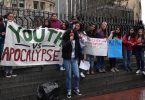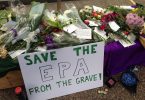It was only a year ago when the idea of a Green New Deal entered the American public sphere with a big splash. When a group of young activists, joined by an idealistic new crop of congresswomen, stormed the incoming house speaker’s office to demand nothing less than the wholesale transformation of unsustainable industrial systems into regenerative and equitable social and economic structures, few could have predicted just how rapidly and profoundly their action would shift the country’s political and moral ground.
The term “Green New Deal” had been floating around various progressive circles since 2007, when New York Times columnist Thomas Friedman first started using it as a moniker for a panoply of market-based climate solutions, from taxing carbon to creating incentives for wind and solar energy. As far back as 2009, UN Environment expanded the idea to “A Global Green New Deal” in a policy report that sought to connect economic recovery and poverty eradication with reduced carbon emissions and ecosystem degradation.
However, it wasn’t until that day in November 2018 when the promise of this modern version of the original New Deal—a series of programs, public work projects, financial reforms, and regulations enacted in the 1930s by President Franklin D. Roosevelt to dig the United States out of depression—was catapulted onto the national stage. Supported by a vast majority of Americans as an ambitious but viable blueprint to addressing an unprecedented climate emergency, the Green New Deal has not only become a rallying cry for a new generation and a litmus test for political candidates, but produced congressional declarations and policy proposals in the form of the Green New Deal Resolution and, most recently, The Green New Deal for Public Housing Act.
And it’s not just in the United States that these three simple words have sparked widespread optimism. From Canada to Spain to the United Kingdom, a growing number of countries around the world have been framing their policy proposals around a broader Green New Deal framework. While local conditions and specific prescriptions vary for each country, there are now even calls for an International Green New Deal, modeled after the Marshall plan that followed World War II. The thinking goes that this transnational scale is needed to bring geographic, historic and technological equity to the process of protecting and repairing a biosphere we all share.
What do cities have to do with all of this?
In short, everything.







